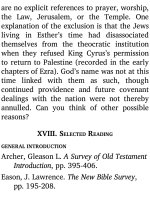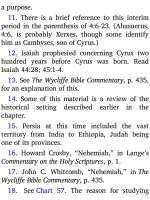Jensens survey of the old testament adam 145
Bạn đang xem bản rút gọn của tài liệu. Xem và tải ngay bản đầy đủ của tài liệu tại đây (118.95 KB, 4 trang )
are no explicit references to prayer, worship,
the Law, Jerusalem, or the Temple. One
explanation of the exclusion is that the Jews
living in Esther’s time had disassociated
themselves from the theocratic institution
when they refused King Cyrus’s permission
to return to Palestine (recorded in the early
chapters of Ezra). God’s name was not at this
time linked with them as such, though
continued providence and future covenant
dealings with the nation were not thereby
annulled. Can you think of other possible
reasons?
XVIII. SELECTED READING
GENERAL INTRODUCTION
Archer, Gleason L. A Survey of Old Testament
Introduction, pp. 395-406.
Eason, J. Lawrence. The New Bible Survey,
pp. 195-208.
Free, Joseph P. Archaeology and Bible History,
pp. 224-54.
Phillips, John. Exploring the Scriptures, pp.
87-94.
Whitcomb, John C., Jr. Study graph on Old
Testament Kings and Prophets.
Whitley, C. F. The Exilic Age.
Wood, Leon J. A Survey of Israel’s History,
pp. 377-411.
COMMENTARIES AND RELATED STUDIES
Armerding, Carl. Esther.
Bruce, F. F. Israel and the Nations, pp. 93119.
Crosby, Howard. “Nehemiah.” In Lange’s
Commentary on the Holy Scriptures.
Ironside, H. A. Notes on the Book of Ezra.
Luck, G. Coleman. Ezra and Nehemiah.
Everyman’s Bible Commentary.
Morgan, G. Campbell. Living Messages of the
Books of the Bible, pp. 236-82.
Pfeiffer, Charles F., and Harrison, Everett F.
The Wycliffe Bible Commentary, pp. 42357.
Pfeiffer, Charles F., and Vos, Howard F. The
Wycliffe Historical Geography of Bible
Lands.
Redpath, Alan. Victorious Christian Service.
1. Although the book of Esther is not about
this return, its story is dated during the time
span of Ezra, as will be seen later.
2. Steven Barabas, “Captivity,” in The
Zondervan Pictorial Bible Dictionary, p. 147. Read
Ezekiel 36:24, which clearly teaches that the
Jews who eventually returned to Canaan were
gathered from many countries.
3. The number seventy may have been a
round number, as is often the case in Scripture.
4. If Jeremiah’s prophecy is interpreted from
an ecclesiastical standpoint, with the Temple as
the key object, then the seventy-year period
extended from the destruction of the Temple in
5 8 6 B.C. to the year of completion of its
reconstruction, which was 516 B.C.
5. Most of the dates of Chart 57 are those of
John C. Whitcomb’s Chart of Old Testament Kings
and Prophets.
6. Zerubbabel is probably the Sheshbazzar
referred to in Ezra 1:8,11.
7. No large contingent of Jews was involved
in this return.
8. The rst division into two books in the
Hebrew Bible was made in A.D. 1448.
9. The phrase “scribe skilled” (Ezra 7:6) is
translated by the Berkeley Version as “scribe,
well versed.”
10. The references to Ahasuerus (Xerxes) and
Artaxerxes in 4:6-7 are part of the parenthesis
4:6-23, inserted out of chronological order with









